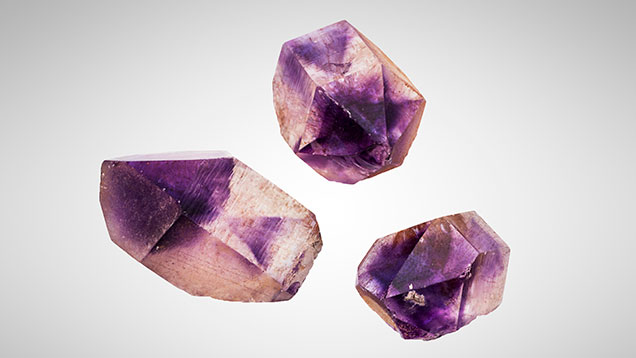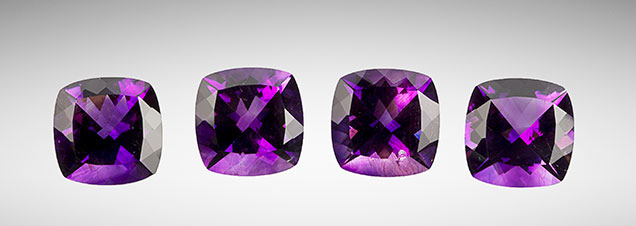Moroccan Amethyst:
Mining and Marketing

Characteristic “hourglass” color zoning (figure 1) and striking red hematite “finger” inclusions help distinguish Moroccan amethyst. Although amethyst is readily available on the market, the material from Boudi in southern Morocco stands out. While Moroccan amethyst has been featured in G&G previously (F. Troilo et al., “Amethyst from Boudi, Morocco,” Spring 2015, pp. 32–40), we gathered some fresh insights on the mine and the marketing strategy for this material from Alaeddine Rafei, who directs grading and sales for Geostone Group in Morocco.
About 40 years ago, a group of nomads were stuck in a storm in the Anti-Atlas mountain range of southern Morocco. The next morning, they found purple crystals on the washed ground. The nomads kept bringing the crystals to tourist shops in the villages nearby. Seven years ago, a geologist and a cofounder of Geostone Group finally had the stones analyzed by GIA and confirmed that they are amethyst. Mining started in 2011–2012 and has continued on a small scale since then. From 2011 to 2015, the miners mainly used hand tools to remove the earth and extract the crystals. As the wall has gotten pushed further back, excavators have been used since 2015 to move earth. The miners are still hand picking crystals out of the removed earth.
Rough amethyst crystals are transported to the company’s warehouse in Casablanca for washing and grading. Washing is done with water and acid. Rafei explained the four grades of Moroccan amethyst. The topmost grade consists of double-terminated single crystals, which are extremely rare. Rafei explained that only 1% of the production is gem quality (figure 2), of which only 2% are the double-terminated crystals. Next come the AAA grade, which refers to the deep purple stones, and the slightly less purple AA grade. The AA grade is the most common on the market. The fourth grade is a category called Rose du Maroc. Amethysts falling to this grade have an even lighter purple color than AA stones.

Marketing these amethysts is an even greater challenge. As people can imagine, the rough amethyst market is very competitive, since there are many sources in different countries. In 2013, when Geostone’s founders brought their Moroccan amethysts to Tucson to test the market, they went home deflated by the feedback. Large colored stone cutting companies see little value in these amethysts. Luckily, the founders got connected with world-renowned gem carver Glenn Lehrer, who became their marketing advisor and took Moroccan amethyst in a completely different direction. Lehrer saw the unique features in these stones and applied his cutting styles and award-wining patented cuts to show off their beauty. The special cuts also better use the rough. The yield of Moroccan amethysts at a normal cutting factory is only about 8%. When Lehrer’s special cuts are applied, the yield was increase to an average of 20% for top-quality stones. He also introduced these amethysts to Gems TV. Instead of selling the rough to gem cutters, the company now offers faceted stones and finished amethyst jewelry directly to consumers through multiple TV programs in different countries.
As a result, Moroccan amethyst is not just another amethyst. It is now a brand and trademark of Geostone Group. The mine-to-market story is sold with the gems. The story even landed Moroccan amethyst in the Rio Grande catalog. In return, the company is actively involved in community building in the mining area. It only hires local Berbers to work in the mine, offering them a good salary and health care. During the past several years, Geostone Group has kept production quite stable and limited mining crew sizes to around 20 people. Wells, roads, electricity, and designated vehicles for schoolchildren and villagers are all provided using profits from the amethyst mine. In 2016, Geostone Group received an award from the Moroccan government to highlight its contributions to social responsibility and gem mining in Morocco.



